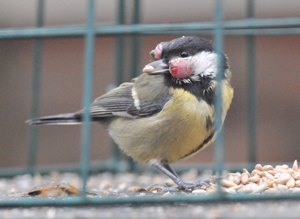Learn about the symptoms and spread of avian pox, and which species tend to be affected.
Avian pox is caused by a virus, and sporadic cases of the disease are observed each year in British garden birds.
- Please note: avian pox is a different disease from avian influenza.
Pathology and disease spread

Affected birds develop warty or tumour-like growths, often on the head (around the eyes or beak), wings or legs. The growths can become very large and may impede the bird by, for example, restricting vision. This can lead to an increased risk of predation or of secondary infection. The growths are usually grey, red, pink or yellow in colour.
Transmission appears to be by one of three routes: namely, biting insects (e.g. mosquitoes), bird-to-bird contact or indirect contact, the latter through contaminated bird feeders or feeding surfaces. The virus is relatively resistant and can persist for long periods outside of the host. Avian poxes do not appear to be infectious to humans or other mammals.
Species affected
Although many of the sporadic cases have involved birds like Wood Pigeon and Dunnock, we have seen an increasing number of cases during late summer in Great Tits.
What you can do
A few simple precautions will help limit the spread of avian pox in gardens and on feeders.
- A few simple precautions will help limit the spread of disease in gardens and on feeders. Learn more about good garden feeding hygiene.
- Help us understand disease in wildlife by reporting any cases that you see. Information on diseases and other forms of mortality in garden wildlife is being collected through Garden Wildlife Health.
- Avian pox is a different disease from avian influenza. Please see our separate page for additional health and safety risks relating to avian influenza.
Report disease in your garden
Report sightings of diseased birds and other wildlife to the Garden Wildlife Health project: a partnership between ZSL, BTO, Froglife and RSPB.